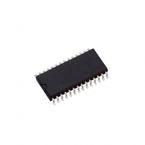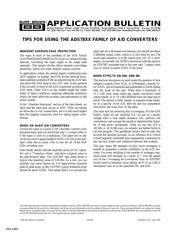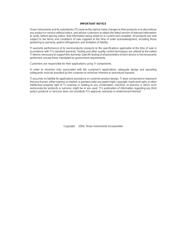herunterladen

INHERENT OVERVOLTAGE PROTECTION
The input to each of the members of the ADS Family
(ADS7804/05/06/07/08/09/10/19, so far) is a resistor divider
network, converting the input signal to the range used
internally. This resistor divider offers inherent overvoltage
protection, which will often simplify analog circuitry.
In applications where the analog signal conditioning uses
±12V supplies (or higher), the ADS divider network elimi-
nates potential problems if the op amp driving the ADS fails
and drives the ADS input to the +12V rails. It also protects
if the circuitry in front of the ADS is powered up before the
ADS itself. Older ADCs on the market might fail under
either of these conditions, requiring additional protection
which can itself affect the accuracy and performance of the
whole system.
In the “Absolute Maximum” section of the data sheets, we
show that the input pins can go to ±25V. From our testing
we know this is very conservative, but it is still much higher
than the supplies commonly used for analog signal condi-
tioning.
NOISE ON 16-BIT A/D CONVERTERS
Ground the input of a good 12-bit converter, convert a few
thousand times, and you should see only 1-2 output codes (2
if the input is close to a transition). The same test on any
16-bit successive approximation (SAR) A/D will yield mul-
tiple codes due to noise. This is true for all 16-bit SAR
A/Ds including ours.
Data sheets should indicate expected noise for DC inputs.
We call it “Transition Noise”, and show a typical value in
the specification table. The ADS7807 data sheet shows a
typical rms transition noise of 0.8LSBs. As a rule, you can
multiply rms noise figures by 6 to approximate expected
peak-to-peak noise, so the ADS7807 typical transition noise
should be about 5LSBs. This means that if you ground the
The information provided herein is believed to be reliable; however, BURR-BROWN assumes no responsibility for inaccuracies or omissions. BURR-BROWN assumes
no responsibility for the use of this information, and all use of such information shall be entirely at the user’s own risk. Prices and specifications are subject to change
without notice. No patent rights or licenses to any of the circuits described herein are implied or granted to any third party. BURR-BROWN does not authorize or warrant
any BURR-BROWN product for use in life support devices and/or systems.
©
1995 Burr-Brown Corporation AB-095 Printed in U.S.A. June, 1995
APPLICATION BULLETIN
®
Mailing Address: PO Box 11400 • Tucson, AZ 85734 • Street Address: 6730 S. Tucson Blvd. • Tucson, AZ 85706
Tel: (520) 746-1111 • Twx: 910-952-111 • Telex: 066-6491 • FAX (520) 889-1510 • Immediate Product Info: (800) 548-6132
TIPS FOR USING THE ADS78XX FAMILY OF A/D CONVERTERS
input and run a thousand conversions, you should see about
5 different output codes, which is in fact what we see. The
worst-case transition is at the major-carry (0V for a ±10V
range); we recently ran 30,000 conversions with the input to
an ADS7807 grounded and in fact saw only 7 output codes
(one of which occurred 0.03% of the time).
NOISE EFFECTS ON DNL AND INL
The previous discussion on noise raises the question of how
Integral Linearity Error (ILE), or Differential Linearity Er-
ror (DLE), can be measured and guaranteed to levels tighter
than the noise of the part. What does a maximum of
+1.5 LSB error mean when any signal conversion could
output results +2 or +3 LSBs different from the ideal due to
noise? The answer is fairly simple: to measure actual linear-
ity of a specific 16-bit A/D, both we and our competition
look below the noise floor of the parts.
The main tool for achieving this is averaging. For the ADS
Family, when we are checking ILE, we put in a known
voltage from a very stable reference D/A, perform 256
conversions, and average the results to determine the linear-
ity of that point. Incidentally, when we say that ILE is
±3LSBs or ±1.5LSBs max, we actually use tighter limits in
our test program. The guardband insures that we take into
account the absolute accuracy of our reference D/A (which
is itself regularly calibrated) plus repeatability constraints on
any one test system and variations between test systems.
This also raises the question of how much averaging is
needed to guarantee a certain confidence in the A/D con-
verter. For every doubling in the number of averages, tran-
sition noise will decrease by a factor of 1 over the square
root of two. Averaging 64 conversions from an ADS7807
would result in transition noise adding ±1/10 of an LSB of
uncertainty (one σ) to the specified INL and DNL.
SBAA003




